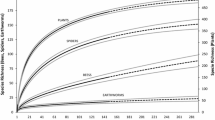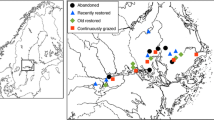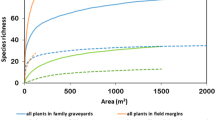Abstract
About 20 % of the natural grasslands in Sub-Saharan Africa have been converted to cropland and 80 % of the converted area is managed by small-scale farmers. Despite the large contribution of small-scale subsistence farming to agricultural expansion in Sub-Saharan Africa only few studies investigated the effects on insect biodiversity. We studied the effects of the conversion of savannah to small-scale extensively managed ruderal areas and corn fields on grasshopper communities (Orthoptera: Caelifera). The study was conducted on the eastern slopes of Mount Kilimanjaro, Tanzania. Three plots per land use type were established and grasshoppers were repeatedly collected between September and December 2010 using standardized transect walk methods. In comparison to the natural savannah, cornfields exhibited lower numbers and densities of grasshopper species, while ruderal areas exhibited similar species richness. However, vegetation cover was the best predictor for species richness, with the number of grasshopper species nearly doubling from plots with scarce vegetation to those with a dense grass cover. The composition of grasshopper communities differed between land use types and vegetation cover, with habitat generalists being scarce. Therefore, the species richness of all land use types combined was considerably higher than the richness of single land use types. We found no rare or threatened species during sampling. Our study suggests that a mosaic agricultural landscape with areas of savannah and extensively managed ruderal areas may maintain a high biodiversity of grasshoppers. However, the effectiveness of such mosaics is strongly dependent on extensive farm management practises which retain significant amounts of grass cover throughout the year.






Similar content being viewed by others
References
Altieri MA (1999) The ecological role of biodiversity in agroecosystems. Agric Ecosyst Environ 74:19–31
Andersen AN, Ludwig JA, Lowe LM, Rentz DCF (2001) Grasshopper biodiversity and bioindicators in Australian tropical savannas: responses to disturbance in Kakadu National Park. Austral Ecol 26:213–222
Appelhans T, Mwangomo E, Otte I, Detsch F, Nauss T, Hemp A (2014) Monthly and annual climate data averaged from 2011 to 2013 for 79 research plots on the southern slopes of Mt. Kilimanjaro. V 1.0. ZENODO. doi: 10.5281/zenodo.11695
Badenhausser I, Gouat M, Goarant A, Crnulier T, Bretagnolle V (2012) Spatial autocorrelation in farmland grasshopper assemblages (Orthoptera: Acrididae) in Western France. Environ Entomol 41:1050–1061
Barton K (2012) MuMIn: Model selection and model averaging based on information criteria. R package version 1.12-1. http://CRAN.R-project.org/package=MuMIn. Accessed 20 Jan 2015
Batáry P, Orci KM, Báldi A, Kleijn D, Kisbenedek T, Erdős S (2007) Effects of local and landscape scale and cattle grazing intensity on Orthoptera assemblages of the Hungarian Great Plain. Basic Appl Ecol 8:280–290
Belovsky GE (2000) Do grasshoppers diminish productivity? a new perspective for control based on conservation. In: Lockwood J, Latchininsky A (eds) Grasshoppers, locusts and grassland health. Kluwer Academic Publishers, Dordrecht, pp 7–29
Bjornstad ON (2013) ncf: Spatial nonparametric covariance functions. R package version 1.1-5. http://CRAN.R-project.org/package=ncf Accessed 23 Jan 2015
Bock CE, Bock JH (1991) Response of grasshoppers (Orthoptera: Acrididae) to wildfire in a southeastern Arizona grassland. Am Midl Nat 125:162–167
Borcard D, Gillet F, Legendre R (2011) Numerical ecology with R. Springer, New York
Branson DH, Sword GA (2010) An experimental analysis of grasshopper community responses to fire and livestock grazing in a northern mixed-grass prairie. Environ Entomol 39:1441–1446
Branson DH, Joern A, Sword GA (2006) Sustainable management of insect herbivores in grassland ecosystems: new perspectives in grasshopper control. Bioscience 56:743–755
Chambers BQ, Samways MJ (1998) Grasshopper response to a 40-year experimental burning and mowing regime, with recommendations for invertebrate conservation management. Biodivers Conserv 7:985–1012
Chappell MA, Whitman DW (1990) Grasshopper thermoregulation. In: Chapman RF, Joern A (eds) Biology of grasshoppers. Wiley, New York, pp 143–172
Collinge SK, Forman RTT (1998) A conceptual model of land conversion processes: predictions and evidence from a microlandscape experiment with grassland insects. Oikos 82:66–84
Craig DP, Bock CE, Bennett BC, Bock JH (1999) Habitat relationships among grasshoppers (Orthoptera: Acrididae) at the western limit of the Great Plains in Colorado. Am Midl Nat 142:314–327
Devictor V, Jiguet F (2007) Community richness and stability in agricultural landscape: the importance of surrounding habitat. Agric Ecosyst Environ 120:179–184
Eterovick PC, Figueira JEC (1997) Cryptic coloration and choice of escape microhabitats by grasshoppers (Orthoptera:Acrididae). Biol J Linn Soc 61:485–499
Faith DP, Minchin PR, Belbin L (1987) Compositional dissimilarity as a robust measure of ecological distance. Vegetatio 69:57–68
Gandar MV (1980) Short term effects of the exclusion of large mammals and insects in broad leaf savannah. S Afr J Sci 76:29–31
Gandar MV (1982) The dynamics and trophic ecology of grasshoppers (Acridoidea) in a South African savannah. Oecologia 54:370–378
Gebeyehu S, Samways MJ (2002) Grasshopper assemblage response to a restored national park (Mountain Zebra National Park, South Africa). Biodivers Conserv 11:283–304
Gebeyehu S, Samways MJ (2003) Responses of grasshopper assemblages to long-term grazing management in a semi-arid African savannah. Agric Ecosyst Environ 95:613–622
Gereau RE, Cordeiro N, Cumberlidge N, Hemp C, Hochkirch A, Jones T, Kariuki M, Lange C, Loader SP, Malonza PK, Menegon M, Ndang’ang’a PK, Rovero F, Shirk P (in press) Globally threatened biodiversity of the Eastern Arc mountains and coastal forests of Kenya and Tanzania. J East Afr Nat Hist
Gillon Y (1972) The effect of bush fire on the principal acridid species of and Ivory Coast savanna. Proc Tall Timbers Fire Ecol Conf 11:419–471
Gillon Y (1983) The invertebrates of the grass layer. In: Bouliere F (ed) Ecosystems of the world 13: tropical savannahs. Elsevier, Amsterdam, pp 289–311
Haberl H, Erb KH, Krausmann F, Gaube V, Bondeau A, Plutzar C, Gingrich S, Lucht W, Fischer-Kowalski M (2007) Quantifying and mapping the human appropriation of net primary production in Earth’s terrestrial ecosystems. Proc Natl Acad Sci USA 104:12942–12947
Havemann T, Muccione V (2011) Mechanisms for agricultural climate change mitigation incentives for smallholders. CCAFS Report no. 6. CGIAR research program on climate change, agriculture and food security (CCAFS). Copenhagen, Denmark
Hemp C (2002) New Acrometopae from East Africa (Tettigoniidae: Phaneropterinae). J Orthoptera Res 11:67–76
Hemp A (2006) Vegetation of Kilimanjaro: hidden endemics and missing bamboo. Afr J Ecol 44:305–328
Hemp C (2009) Annotated list of Caelifera (Orthoptera) of Mt. Kilimanjaro, Tanzan. J Orthoptera Res 18:183–214
Hemp C (2013) Annotated list of Ensifera (Orthoptera) and further records on Caelifera (Orthoptera) of Mt. Kilimanjaro. Tanzan Zootaxa 3613:301–342
Hochkirch A, Adorf F (2007) Effects of prescribed burning and wildfires on Orthoptera in Central European peat bogs. Environ Conserv 34:225–235
Hothorn T, Bretz F, Westfall P (2008) Simultaneous inference in general parametric models. Biom J 50:346–363
Joern A (1982) Vegetation stucture and microhabitat selection in grasshoppers (Orthoptera, Acrididae). Southwest Nat 27:197–209
Joern A, Gaines SB (1990) Population dynamics and regulation in grasshoppers. In: Chapman RF, Joern A (eds) Biology of grasshoppers. Wiley, New York, pp 415–482
Joern A, Laws AN (2013) Ecological mechanisms underlying arthropod species diversity in grasslands. Annu Rev Entomol 58:19–36
Kaspari M, Ward PS, Yuan M (2004) Energy gradients and the geographic distribution of local ant diversity. Oecologica 140:407–413
Keller D, van Strien MJ, Herrmann M, Bolliger J, Edwards PJ, Ghazoul J, Holderegger R (2013) Is functional connectivity in common grasshopper species affected by fragmentation in an agricultural landscape? Agric Ecosyst Environ 175:39–46
Kemp WP (1992) Rangeland grasshopper (Orthoptera: Acrididae) community structure: a working hypothesis. Environ Entomol 21:461–470
Kruess A, Tscharntke T (2002) Grazing intensity and the diversity of grasshoppers, butterflies, and trap-nesting bees and wasps. Conserv Biol 16:1570–1580
Lockwood JA (1997) Rangeland grasshoppers ecology. In: Gangwere SK, Muralirangan MC, Muralirangan M (eds) The bionomics of grasshoppers, katydids and their kin. CABInternational, Wallingford, pp 83–101
Marini L, Fontana P, Scotton M, Klimek S (2008) Vascular plant and Orthoptera diversity in relation to grassland management and landscape composition in the European Alps. J Appl Ecol 45:361–370
Mbonile MJ, Misana BM, Sokoni C (2003) Land use change patterns and root causes on the southern slopes on Mount Kilimanjaro, Tanzania. Land use change impacts and dynamics (LUCID) Project Working Paper 25. International Livestock Research Institute, Nairobi
Millennium Ecosystem Assessment (2005) Ecosystems and human well-being: synthesis. World Resources Institute, Washington, DC
Miller RH, Onsager JA (1991) Grasshopper (Orthoptera: Acrididae) and plant relationships under different grazing intensities. Environ Entomol 20:807–814
Minchin PR (1987) An evaluation of the relative robustness of techniques for ecological ordination. Vegetatio 69:89–107
Nagayets O (2005) Small farms: current status and key trends. The future of small farms: Proceedings of a research workshop, Wye, UK
O’Neill KM, Olson BE, Rolston MG, Wallander R, Larson DP, Seibert CE (2003) Effects of livestock grazing on rangeland Orthoptera (Orthop-tera: Acrididae) abundance. Agric Ecosyst Environ 97:51–64
Oksanen J, Guillaume Blanchet F, Kindt R, Legendre P, O’Hara RB, Simpson GL, Solymos R, Stevens MHH, Wagner H (2011) vegan: community ecology package. R package version 1.17-7. http://CRAN.R-project.org/package=vegan Accessed 24 March 2011
Pinheiro J, Bates D, DebRoy S, Sarkar D, the R Development Core Team (2011) nlme: Linear and Nonlinear Mixed Effects Models. R package version 3.1-98. http://CRAN.R-project.org/package=nlme. Accessed 02 March 2011
Quinn MA, Johnson PS, Butterfield CH, Walgenbach DD (1993) Effect of grasshopper (Orthoptera: Acrididae) density and plant composition on growth and destruction of grasses. Environ Entomol 22:993–1002
R Development Core Team (2011) R: a language and environment for statistical computing. R Foundation for Statistical computing, Vienna, Austria. http://www.r-project.org
Rüdisser J, Tasser E, Tappeiner U (2012) Distance to nature—a new biodiversity relevant environmental indicator set at landscape level. Ecol Indic 15:208–216
Samways MJ (1994) Insect conservation biology. Springer, New York
Samways MJ (1997) Conservation biology of Orthoptera. In: Gangwere SK, Muralirangan MC, Muralirangan M (eds) The bionomics of grasshoppers, katydids and their kin. CAB International, Wallingford, pp 481–496
Samways MJ, Kreuzinger K (2001) Vegetation, ungulate and grasshopper interactions inside vs. outside an Africa savannah game park. Biodiv Conserv 10:1963–1981
Samways MJ, Sergeev MG (1997) Orthoptera and Landscape Change. In: Gangwere SK, Muralirangan MC, Muralirangan M (eds) The bionomics of grasshoppers, katydids and their kin. CAB International, Wallingford, pp 147–159
Steck CE, Bürgi M, Bolliger J, Kienast F, Lehmann A, Gonseth Y (2007) Conservation of grasshopper diversity in a changing environment. Biol Conserv 138:360–370
Strimmer K (2008) Fdrtool: a versatile R package for estimating local and tail area-based false discovery rates. Bioinformatics 24:1461–1462
UNDP, Unep, World Bank and WRI (2000) A guide to world resources 2000–2001: people and ecosystems: a fraying web of life. World Resources Institute, Washington, DC
Vrdoljak SM, Samways MJ (2014) Agricultural mosaics maintain significant flower and visiting insect biodiversity in a global hotspot. Biodiv Conserv 23:133–148
Walther BA, Moore JL (2005) The concepts of bias, precision and accuracy, and their 35 use in testing the performance of species richness estimators, with a literature review of estimator performance. Ecography 28:815–829
Zhou Y (2011) Smallholder Mapping II: trends in demographics and driving forces. Syngenta Foundation for Sustainable Agriculture
Acknowledgments
We are grateful to the Tanzanian Commission for Science and Technology for allowing us to conduct research on grasshoppers. We thank A. Hemp for support during the field work and two anonymous reviewers for valuable comments on the manuscript. The study was made possible by a scholarship of the German Academic Exchange Service and by support of the German Science Foundation within the research unit “Kilimanjaro ecosystems under global change: linking biodiversity, biotic interactions and biogeochemical ecosystem processes” (FOR1246, SP 7; www.kilimanjaro.biozentrum.uni-wuerzburg.de).
Author information
Authors and Affiliations
Corresponding author
Electronic supplementary material
Below is the link to the electronic supplementary material.
Rights and permissions
About this article
Cite this article
Kuppler, J., Fricke, J., Hemp, C. et al. Conversion of savannah habitats to small-scale agriculture affects grasshopper communities at Mt. Kilimanjaro, Tanzania. J Insect Conserv 19, 509–518 (2015). https://doi.org/10.1007/s10841-015-9772-7
Received:
Accepted:
Published:
Issue Date:
DOI: https://doi.org/10.1007/s10841-015-9772-7




